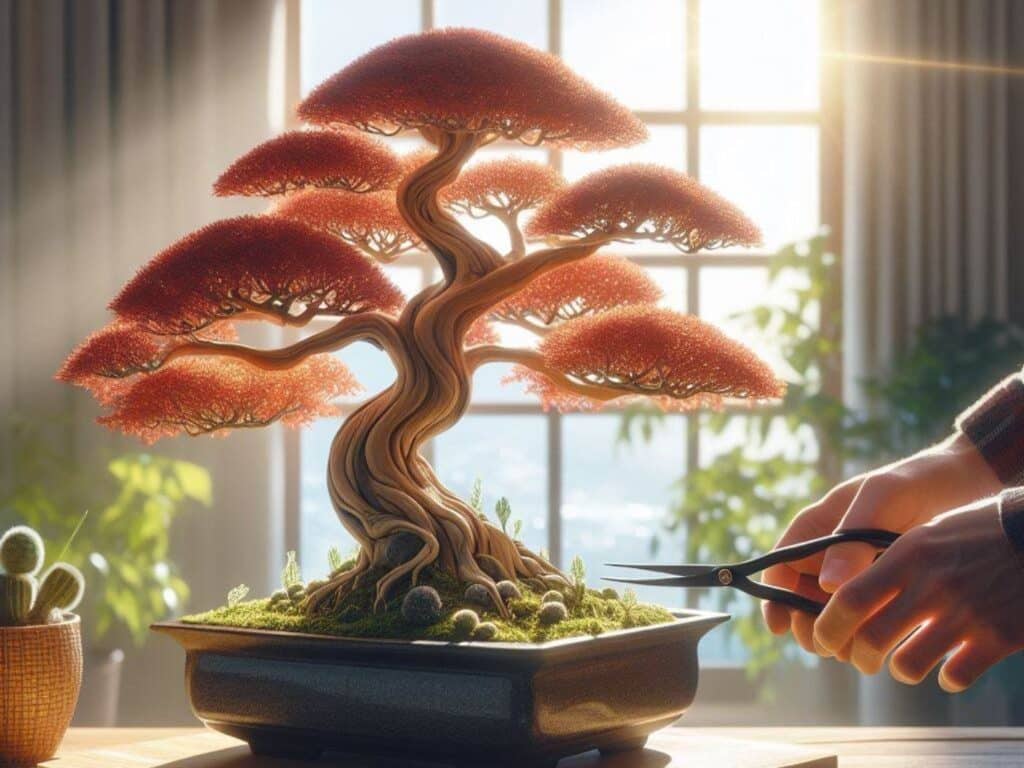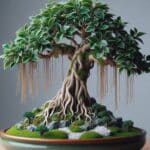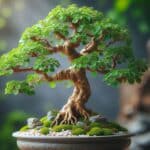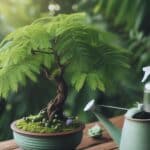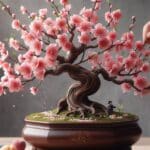If you love bonsai trees that bloom vigorously, you can undoubtedly consider growing a flame (Delonix regia).
This miniature tree, also known as the flamboyant tree, royal Poinciana, or peacock flower tree produces vivid fiery red or orange flowers and fern-like leaves that can give your spaces an exotic appearance.
The tree originates from Madagascar but is successfully grown in tropical climates worldwide. It isn’t the easiest bonsai tree to grow, but it is popular because it can look beautiful and is well-suited for indoor spaces. The delicate foliage of the tree is also easy to prune, and the stump is relatively easy to train into a desirable bonsai shape.
If you want to plant, grow, and train a flame tree bonsai successfully, paying close attention to its care needs is best. Let’s discuss growing and caring for this tiny yet interesting tree.
Plant Facts
| Scientific name | Delonix Regia |
| Common names | Flamboyant, Royal poinciana, flame tree, peacock flower, gold mohair, and royal flame tree |
| Family | Fabaceae |
| Plant Type | Bonsai tree, ornamental tree, tropical plant |
| Height and Width | 30 – 40ft. tall (natural form), 16–60 inches. high (bonsai form) |
| Origin | Native to Madagascar |
| Flower colors | Crimson red to orange-red |
| Foliage color | Bright green |
| Sun Exposure | Direct sunlight with minimum of 6 hours of direct sun |
| Soil Type & pH | Well-drained clay, loam, or sand soil with any pH level. |
| Special features | Low Maintenance. Quick growth during spring and summer, Ideal for medium to large bonsai creations |
What Does Flame Tree Bonsai Look Like
Flame trees can reach up to 40 feet tall and 40 feet wide in natural settings. These deciduous trees become dormant for the winter months but will produce vibrant flowers from spring to summer, making the tree look rather impressive.
When all the flowers have been spent, this tree will still look striking because it produces bold green leaves that remind of fern foliage. These trees overgrow and tend to take on a natural umbrella shape with a thickened stump.
Bonsai flame trees are miniaturized versions of natural trees. They look very similar, and the foliage tends to stay more delicate. However, the flowers of these small trees are bigger in scale and tend to be much more impressive on a small-sized tree.
Flame tree bonsai are often trained to maintain that umbrella canopy shape, but bonsai enthusiasts play slightly with the stump design. They often grow into s-curved, slanting, double trunks or cascade shapes.
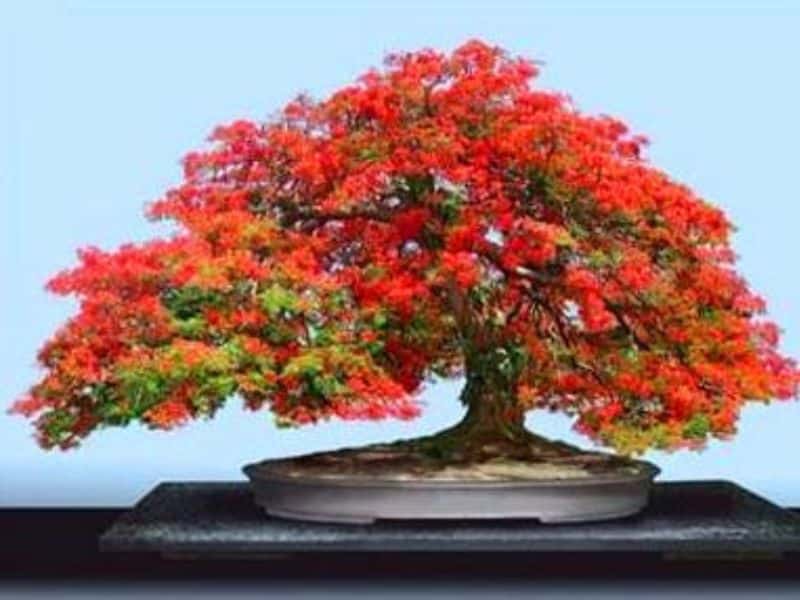
How to Grow a Flame Tree Bonsai
Delonix regia is popular as a bonsai tree because it grows rapidly. This tree can grow up to five feet per year. Its fast growth means you can achieve a bonsai with an aged appearance in less time than many other tree species.
This faster growth rate also means that the tree will require more frequent maintenance in pruning, training, shaping, and repotting.
Here is a quick look at how to grow and plant your fiery red flame tree bonsai.
Propagation
Flame tree bonsai are mostly propagated from seed. This is because the plant has such a quick growth rate and can quickly become too big to bonsai.
You must first wait for the seed pods to ripen and pop open to propagate the tree from seed. Collect the seeds and follow the following steps to germinate your little tree.
Step 1
Start by soaking the seeds in water for a day or two before planting. This will soften up the outer shell.
Step 2
You can now grab the seeds and scarify the seed’s hard outer shell. The idea is to nick the outer shell with a knife so the roots can quickly germinate.
Step 3
Plant the seeds 1 – 6 inches deep in a moist potting mix. You can position the container in a warm outdoor area with some partial shade. The soil should be kept moist for 1 – 3 weeks.
Step 4
Once the seeds germinate, the seedlings will grow quickly. They can be transplanted in containers with well-drained planting soil or potting soil with lots of organic matter. The seedlings should be kept moist but not too wet until it is large enough to transform into a bonsai tree.
Soil
Bonsai trees are planted in small pots with less soil and, as such, have access to fewer nutrients. Planting your seedling in a pot filled with nutrient-rich potting soil is very important. The right soil should drain well; it can be a mixture of loam and sandy soil with lots of organic matter. These trees take well to all soil types but grow best in slightly acidic soil.
Pruning
The best time to prune a flame tree is just after its dormancy stage and before the new growing season begins. To keep these trees small, they need to be hard-pruned. At this point, the tree won’t have any leaves yet which makes it very easy to clearly see all the branches.
Take some time to study the tree and choose a bonsai shape that is most likely to work well with your tree’s natural structure.
Top the lead branch of the tree to encourage some branching. You can now trim back any unwanted branches, remove damaged stems, and thin out some interior branches to promote air circulation.
Because this tree grows vigorously, you will need to regularly prune it during its growing season. Keep a watchful eye on the tree and cut off any vigorously growing branches or overly large leaves that might hinder its shape. Hard pruning will also encourage some healthy growth so your tree can stay beautiful.
Wiring
The best time to wire a flame tree is during springtime. First, you will need to identify branches you would like to wire to change their shape or growing direction.
Next, you will need to cover these branches with some raffia paper. This product will protect the branches from scarring and will keep them in good condition.
Coil aluminum or copper wire around the stem or branches you want to modify. Afterward, you can bend the tree into its desired shape. You can also use guy wiring or ropes to shape older or woodier branches or bend them slightly downwards.
Keep an eye on your tree after wiring it. Bonsai tree wires should be removed after about 1 – 3 months, depending on the tree’s growth rate. If you see the wires bite into the tree’s bark, then the wires should be removed.
If the tree still doesn’t have the desired shape after removing the wires, then you can re-wire it again.
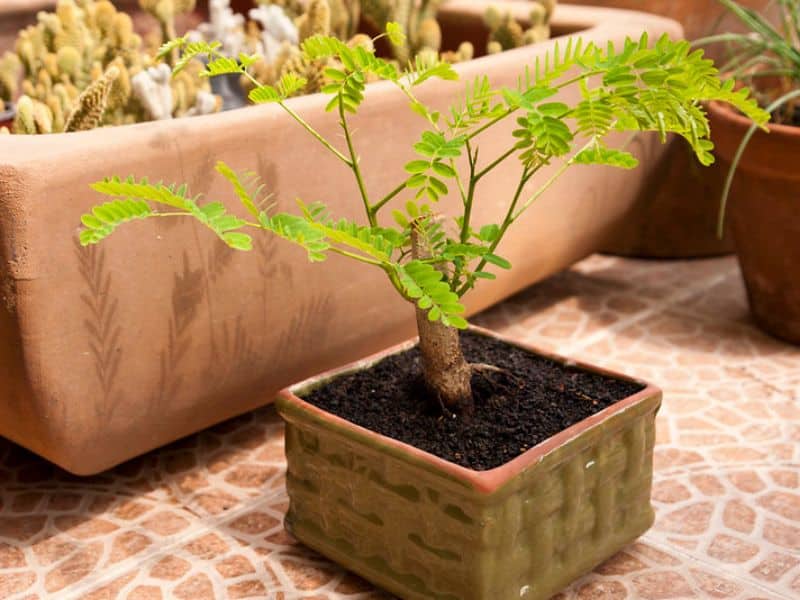
Repotting and Transplanting
Flame tree bonsai produces a shallow root system, so you should select a shallow but wide pot. These trees do require regular repotting to maintain their small size. If it isn’t repotted often enough, it can also suffer from a lack of nutrients, and the root system will become too overgrown it may result in root rot.
It is best to repot these trees every one to two years. Here is a quick look at how to repot these tiny trees.
Step 1
Start by carefully removing the tree from the container. Clear off excess soil from around the root ball and roots so you will have a clear view of the entire root system.
Step 2
You will need to remove about one-third of the entire root system. Start by clearing off any dead roots and cut away strong roots that might be too vigorous for the container. Trimming off the large roots is also helpful for keeping the tree small.
Step 3
Repot the plant in some fresh soil. It is best to use a slightly acidic soil type that is rich in organic matter. Your soil should drain well or the tree might develop root rot.
Step 4
Water the tree well for the first few weeks until the tree settles and keep away from harsh sunlight for the first week.
How to Care for a Flame Tree Bonsai
Once your royal poinciana bonsai is grown, pruned, and potted in a bonsai pot, you will still need to monitor it to keep it healthy and strong constantly. Let’s quickly look at the best way to care for this ornamental tree.
Water
Royal poinciana is a tropical tree that loves high humidity, moisture, and heat. It is very important to water this tree regularly. The tree should be deeply watered at least once a week. It is best to keep the soil moist at all times, but the soil shouldn’t stay soggy, or the roots will start to rot.
You should water the tree in dry and warm regions more than once a week. The soil should never be allowed to dry out completely because this will cause damage to the root system.
Sunlight
In tropical or subtropical regions, this tree can be placed outdoors throughout the year. In cooler subtropical regions, the tree can be kept indoors to protect it from the cold.
A flame tree prefers direct sunlight with a minimum of 6 hours of direct sun per day. It is best to position an indoor tree on a sunny windowsill and to take it outdoors for some direct sunlight during the warmer summer months.
If the tree doesn’t receive enough direct sunlight, it probably won’t produce too many bright red flowers.
Temperature and Humidity
These trees prefer warmer climates with a temperature range of 60 – 85 degrees F. In warmer areas, they can be kept outside throughout the year but in colder regions, they should be brought indoors to protect them from cold temperatures.
The trees also love lots of humidity. If you are keeping your bonsai tree indoors then it is best to grow it on top of a humidity tray.
Fertilizer
You will need to fertilize these trees because they regularly prefer nutrient-rich soil. It is best to fertilize the tree every two weeks with a liquid fertilizer. The fertilizer can be reduced to only once a month during winter because the tree will be dormant during this stage.
Pests and Diseases
Flame bonsai can suffer from the same pests and diseases as any other flame tree in your garden. Here is a quick look at the most common pests and diseases that might affect the tree.
Scales
Scales are a pretty common issue in royal poinciana trees. These pests can be treated with a mild pesticide or you can use a little bit of rubbing alcohol to kill the pests once every couple of weeks.
Looper caterpillars
Looper caterpillars can also attack your tree. These pests can be manually removed and you can prune away any affected or ruined buds and leaves to keep the tree beautiful.
Common Varieties and Cultivars of Flame Tree Bonsai
The Delonix regia is the most common tree variety for growing flame tree bonsai. However, there are a couple of other species of trees that are also known as ‘flame trees’; many of these can also be successfully used for growing bonsai. Here is a quick look at some of the most common varieties.
- Queensland tree waratah or red silky oak (Alloxylon flammeum)
- Illawarra flame tree (Brachychiton acerifolius)
- Flame in the Woods (Butea monosperma)
- Chilean flame tree or Chilean firebush (Embothrium coccineum)
Conclusion
A little flame tree bonsai can bring you a lot of joy and is excellent for brightening indoor spaces because they produce vivid blooms and have attractive foliage with a tropical vibe.
These trees are stunning but could be a better variety for complete bonsai beginners because they can be challenging to maintain.
Our guide made it easier for you to decide whether this is the right bonsai tree. If you choose to grow your flame tree, we are certain you will have a blast training and shaping your mini tree.
Up next:

